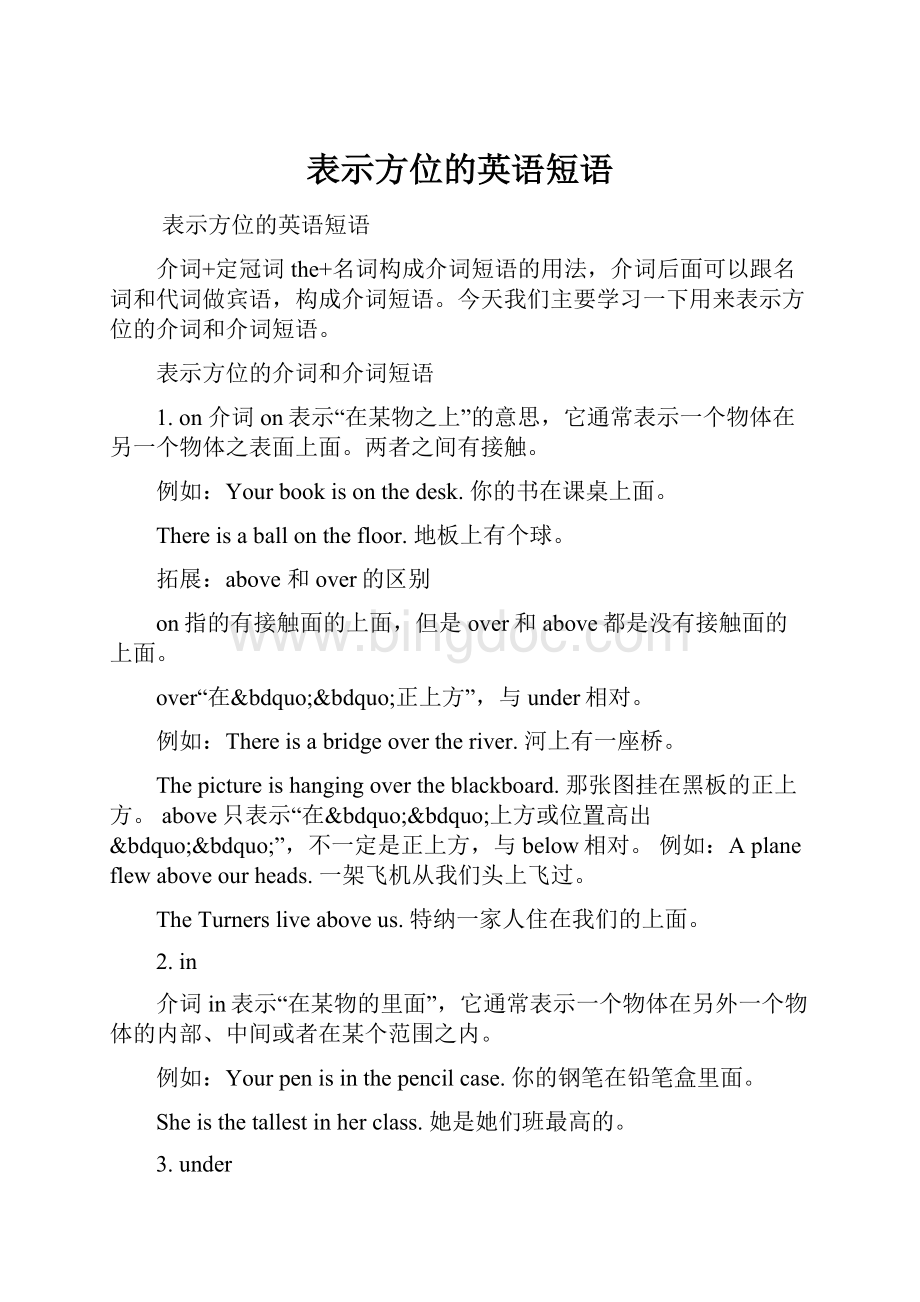表示方位的英语短语Word文档下载推荐.docx
《表示方位的英语短语Word文档下载推荐.docx》由会员分享,可在线阅读,更多相关《表示方位的英语短语Word文档下载推荐.docx(8页珍藏版)》请在冰点文库上搜索。

Aplaneflewaboveourheads.一架飞机从我们头上飞过。
TheTurnersliveaboveus.特纳一家人住在我们的上面。
2.in
介词in表示“在某物的里面”,它通常表示一个物体在另外一个物体的内部、中间或者在某个范围之内。
Yourpenisinthepencilcase.你的钢笔在铅笔盒里面。
Sheisthetallestinherclass.她是她们班最高的。
3.under
介词under表示“在某物的下面”,它通常表示一个物体在另外一个物体的垂直正下面,两者之间没有接触。
Mybikeisunderthetree.我的自行车在树的下面。
Theshoesareunderthechair.鞋在椅子的下面。
under和below的区别
under表示“在&
之下”,通常表示位置处于正下方,与介词over“在&
上方”相对应。
Thereisabookunderthetable.桌子下面有一本书。
Acatissittingunderthetable.一只猫在桌子下面。
below表示“在&
之下”,“在&
的下游”,与介词above相对应,常指在某物体之下,但不一定在该物的正下方。
Heisbelowtheaverageatschool.他的学习成绩在水准以下。
Helookeddownatthehallbelow.他瞧了瞧下面的大厅。
4.behind介词behind表示“在某物的后面”,它通常表示一个物体在另外一个物体的后面。
Yourbrotherisbehindthetree.你的弟弟在树的后面。
Sheisstandingbehindhermother.她站在她妈妈的后面。
5.nextto
nextto是由形容词next和介词to构成的介词短语表示“紧挨着、在某物的旁边”的意思。
Thetableisnexttothewall.桌子紧挨着墙。
6.between
介词between表示某个物体、某人位于两者之间,通常表示一个人、物处于另外两个人、物之间。
Yourdeskisbetweenthedoorandthewindow.你的课桌位于门和窗户之间。
LilysitsbetweenMaryandAnn.丽丽坐在玛丽和安中间。
between和among的区别
between指两者之间,among指三者或三者以上的人或物之间。
Theteacherisamongthestudents.老师在学生们中间。
7.outside
outside指“在&
外面”
Therearemanypeopleoutsidetheroom.房间外有很多人。
Whatdidyouseeoutsidethehall?
你在大厅外看见了什么?
8.near
near在&
附近,与far相对
Ahospitalwasbuiltneartherailwaystation.在火车站附近建了一所医院。
Myhomeisneartheschool.我的家离学校很近。
9.infrontof,inthefrontof
infrontof意为“在&
前面”,表示在物体外部的前面;
inthefrontof表示“在&
前部”,指在物体内部的前面。
Ariverflowsinfrontofthehouse.房子前有一条河。
Thereisaboyinthefrontofthecar.车的前座坐着一个小男孩。
10.aroundaround在&
周围,围绕
Therearemanytreesaroundthevillage.村子周围有很多树围绕。
Thereareflowersaroundthestage.舞台周围摆着鲜花。
11.at
“at”意为“在&
”,可以用在地点前也可以用在时间前。
Let&
rsquo;
smeetattheschoolgate.我们在学校门口见面吧。
Igetupatseveno&
clock.我七点起床。
巩固练习
Ⅰ.把下列词组翻译成英语。
1.在沙发上_____________
2.在桌子底下____________
3.在你的背包里____________4.在抽屉里___________
5.在教室(外部)前面__________
Ⅱ.单项选择。
1.Yourcomputeris______tothedoor.
A.behindB.onC.inD.next
2.Themapis____thewall____ourclassroom.
A.on;
onB.of;
onC.on;
atD.on;
of
3.Look!
Thewindowis_____thewallandthepictureis_____thewall.
onB.in;
inC.in;
onD.on;
in
4.-Whereismyball?
Ican&
tseeit.Look!
It&
s_____thedoor.
A.onB.inC.atD.behind
5.Sallyisveryhappy.Thereisabigsmile______herface.
A.onB.toC.inD.at
6.Myfatherisill(生病),Heis______.
A.inbedB.inthebedC.onbedD.onthebed
7.ThereisamapofChina______thewallintheclassroom.
A.inB.onC.underD.at
8.Therearethreewindows______thewall.
A.inB.onC.atD.to
9.Therearemanyoranges______thetree.Abird______thetreeiseatinganorange.
A.in;
onB.on;
onC.in;
inD.on;
10.-Whattimedoyouusuallygotobed?
-Iusuallygotobed______11:
00.
A.inB.onC.atD.for
11.Wecansee______oldbike______thetree.
A.a;
underB.the;
atC.an;
inD.an;
under
12.Myhatsandcoatsare______.
A.onthebedB.underdeskC.inroomD.underthemybed
13.Heputupamap______thebackwallbecausetherewasahole______it.
onB.at;
inC.on;
at
14.Don&
#39;
tread____thesun.
A.atB.underC.withD.in
15.Theboatispassing___thebridge.
A.throughB.belowC.underD.across
III.用适当的介词填空。
1.Aboyis____thetree.
2.Canyoupick(摘)theapples_____thetree?
3.Thereisapicture_____thewall.
4.Therearetwowindows_____thewall.
5.Ilive_____Shanghai.
Ⅳ.阅读短文回答问题。
Tom&
sroom
It&
ssmallbutnice.AcomputerandsomeCDsareonthedesk.Hisbackpackisonthewall.TheIDcardisonhisbed.Theshoesareunderthebed.Abaseballisonthefloor.
Sally&
sverynice.Thenewpicturesareonthewall.Herdeskisnearthewindow.Someflowersareonthedesk.Whereisherschoolbag?
Oh,it&
sonthechair.Wecan&
tseeahatonthebed,butwecanseeMimi,hercat.
Thetwins&
room
sbigandnice.Twopencilcasesareonthedesk.Manybooksareonthebookcase.It&
sabigbednearthebookcase.Onebackpackisonthefloor,andtheotherisonthechair.Thejacketsarebehindthedoor.Apictureoftheirfatherandmotherisonthewall.
1.Tom&
sIDcardis_______hisbed,andhisshoesare_______thebed.
2.Sally&
scatis________herbed.Herschoolbagis_______thechair.
3.Thebookcaseis________thetwins&
room.Thebigbedis_______thedoor.
4.Twopencilcasesare________thedeskinthetwins&
room.5.Apictureofthetwins&
parentsis_______thewall.
答案与解析
1.onthesofa2.underthedesk3.inyourbackpack4.inthedrawer
5.infrontoftheclassroom
1.D。
本句子是考查介词的用法,但是,介词behind,on,in的后面用冠词the和名词、冠词、介词短语,不和to连用,所以本句子是用形容词next和to连用表示“紧挨着、在旁边”的意思。
2.D。
本句子用介词on和冠词the,名词wall构成介词短语表示“在墙上”的意思,后面用介词of构成名词所有格,表示所属关系,表示无生命的名词所有格的形式用of,而不用&
s形式。
3.C。
本句子是考查介词的用法,表示在某物的表面之上用介词on;
表示在某物内部用介词in。
窗户是在墙的里面所以用介词in;
画是贴在墙的表面上,与墙接触,所以用介词on。
4.D。
从对话前面的句子Ican&
tseeit.和问句可以判断后面的句子是用介词behind表示“在门的后面”,所以选择D是比较符合对话的上下句子意思和情景。
5.A。
句意:
“Sally非常开心,她脸上满脸微笑。
”“在&
上”用介词on。
6.A。
inbed表示“卧床(睡觉)”,此时bed前无需加冠词。
7.B。
地图在墙上,故用介词on。
8.A。
窗户是嵌在墙里面的,故应该用介词in。
9.D。
长在树上的东西用on;
外来的东西用in。
10.C。
点钟前用介词at。
11.D。
“我们可以看见树下有一辆旧自行车。
”;
“一辆自行车”,故选不定冠词,用因为old以原音开头,所以选an;
“在&
底下”用介词“under”。
12.A。
可数名词的前面应该加冠词,所以排除B,C项;
已经有代词修饰时前面不用再加冠词,故排除D项;
因此选A。
13.C。
地图在墙的表面用介词on;
洞是在墙里面,用介词in。
14.D。
“不要在阳光下读书。
在阳光下不用under用in。
15.C。
船从桥下经过,用介词under。
1.不是树上结的果实,表示某物在树上是要用in。
2.树上结的果实“在树上”要用on。
3.墙表面的上面,用介词on。
4.窗户是镶嵌在墙里的,故用介词in。
5.住在哪里,用介词in。
1.on;
under2.on;
on3.in;
behind4.on5.on